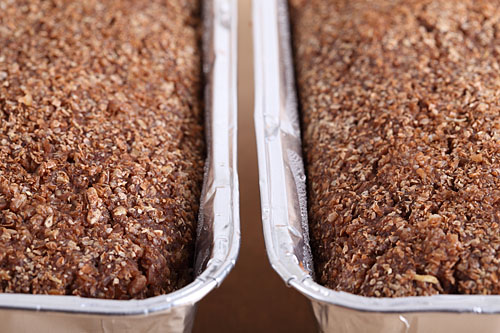
Imaging: 10 hours in the oven at night and then awaken to the aroma of the fresh rye bread!
As a child I loved this dark, moist rye bread, which in Holland we call Frisian Rye bread (‘Fries roggebrood’ or our version of a fine pumpernickel, however the structure is more compact and very moist). I never thought that one day I would make it myself and the result would be so rewarding! You have to be patient with this one, because it takes about 10 hours in the oven, but if you put it in before going to bed you will wake to a wonderful smell of fresh rye bread that has magically transformed itself while you were sleeping. I like it best with mature Dutch cheese with cumin or cloves. Rye bread is also eaten with bacon to accompany split pea soup, one of our proud Dutch culinary traditions. And did I mention it is very healthy too, one of the best ways to get that recommended daily doses of fiber…
makes 2 loaves
Ingredients for the Rye Bread
700 g broken whole grain rye (cracked rye)
200 g whole grain rye flour
50 g fine rye flour (can be substituted with wheat flour)
50 g wheat flour
2 tbsps date syrup or molasses
13 g sea salt
700 ml HOT water
approx. 200 ml water at room temperature
wheat germ for coating
Note: We understand if you do not want to use tin foil. We want to experiment with other options like pullman tins, Dutch ovens or maybe a tin with wet baking paper lid, securely fastened with string. If you use anything else, we would love to hear about it of course!
Making the Rye Bread
Before you start you need two pans of about 20 cm long by 14 cm wide and 4.5 cm high to put the loaves in when they go into the oven. We use (disposable) aluminum pans, the same ones that are used to make sugar loaves. These pans have different measurements (21x10x6) but almost the same volume, so they work great too, the loaves are just a bit smaller and higher than the pans originally used for this type of recipe. Just aim for a volume of about 1260cm³ / 76.89 in³.
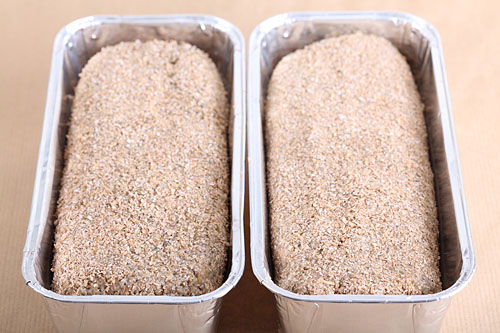
Before their night in the oven the loaves get coated in wheat germ…more fibres please
Start with placing the 700 g broken whole grain rye in a (plastic) bowl and add the HOT water (just off the boil). Mix with a wooden spoon, cover and leave to rest/soak for 2 hours. The broken rye grains will absorb all the water and become soft, this is very important for the rye bread to become a success! Preheat your oven at 110° Celsius/ 230° Fahrenheit (yes, you bake this bread on a low temperature!). Now add the rest of the ingredients, including the 200 g of water at room temperature.
Note: the adding of the exact amount of water is a matter of experience and depends on how soft you want the rye bread to become. You will see what works best for you and your own ingredients as you make the recipe more often. Now knead well by hand or mixer until combined. Be careful a KitchenAid style mixer can handle it because the dough is very tough and sticky, use your hands if your mixer gets too hot or starts acting funny. We use a bigger spiral mixer, brand Hauessler from Germany, that is up to this sort of job. Divide in two equal portions and shape them into loaves that fit in the pans. Roll the loaves through the wheat germ until all sides are thinly covered and place them in the pans.
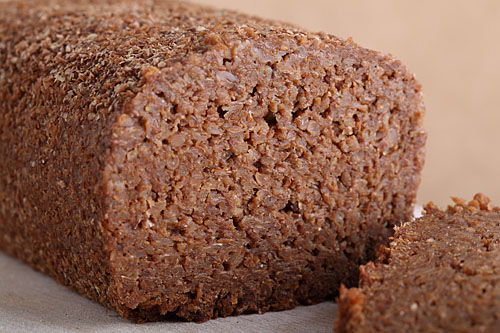
The finished product is lovely and moist and keeps very well in the fridge
Now cover the pans completely with 2 layers of aluminum foil so no moisture can escape. Place the loaves in the preheated oven and leave them there for 9 to 12 hours (we did 9.5 the first time and 10 the second run and they both got good results). Take the pans out of the oven but DO NOT OPEN until completely cooled to avoid losing moisture! This can take several hours, so curb your curiosity.
The baking period needs to be this long because the rye substance is very compact and contains almost no air, making heat transfer slow. This is a very old Dutch (Frisian) recipe, we think this bread was normally baked (cooked almost) during the night on the residual heat of a stove.
Cut into 3-4 mm slices with a wet bread knife (dip in water after each slice), the bread is very crumbly and sticky. You can make little packs of sliced rye bread that keep very well in your fridge for over a week. You can keep the rest for much longer in the freezer.
We like to thank ‘roggebrood fanaat’ at bakkerswereld.org for this excellent recipe.




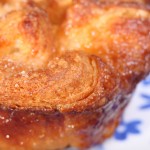
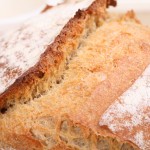
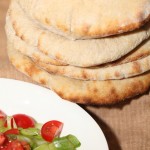
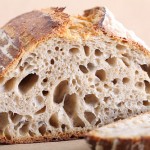
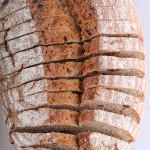
christian says
Awsome very good recipe thx
Weekend Bakers says
Thanks Christian, very glad you like it too!
Baris says
Hey,
I am a Turkish man and i want to tell you my story about roggebrood. I was probably 10-11
years old and it was summer vacation near Aegean sea. Some friends of my aunt brought something from Germany. Those years the world was more “far” from each other i mean, there was no internet and it was not very common to go to the other countries and learn about their culture, i mean it was not as easy as it is today. I was sitting outside and probably i was very tired after swimming all day long in the sea or something. My aunt brought me a piece of roggebrood and she said “here is some germanbread for you”. It was somehow very important for me like “hmm is that what german s eat as bread, interesting, and it’s color , and it has that seeds in it like mosaic, well that’s what germans eat as bread” . I was like “we have that bread and german have that bread, like there is no other options…:) Years past fast and somehow i finished my bachelors in İstanbul then i went to Holland for my masters. It was the first day in Holland and of course i need to buy something from supermarket. What Turks eat besides every dish?= bread. I went to the bread bank of the supermarket and wow, there were many other kinds of bread. But firstly i have seen a pack of mine (dreamy childhood german bread) on the shelve. I was super happy there of course. I stayed there 4-5 years and i tried every brands of volkoren broodjes-dark rye brood. And I still love it with any kind of cheese especially with cream cheese and a slice of tomatoes on it, you can use some herbs and it is healthy, i think it’s healthier than white bread, that’s why i like it. When i grew up i found similar bread here too, very dark and healthy stuff. Bread have it’s own culture too i mean…Maybe i put some Turkish bread recipes here too. Every region here have their own recipes and way of cooking.
Weekend Bakers says
Hello Baris,
Thank you so much for sharing your story with us. It is truly wonderful to hear about the different cultures and the love of bread we all share no matter where we are in the world. And yes, for sure rye bread is healthier than white bread.
And we would love for you to share some Turkish bread recipes with us. That would be awesome, straight from the source.
Happy baking!
Ed & Marieke
veronica says
…so my actual question was supposed to be….which do you use, re:syrup/molasses?
Weekend Bakers says
Hi Veronica,
Any type of molasses will work, but I would stay away from the really, really dark ones, date syrup is just an option and for us it is available in the supermarket (don’t know why, we where surprised to find it there). The result should be very much the same with molasses or date syrup.
Hope you will like it and you will have a great result.
Happy rye baking,
Marieke & Ed
veronica says
i’ve tried roggebrood with the red river cereal recipe and enjoy it, but i’m thrilled to try this authentic recipe….which i have trying to find for some time now
my question is regarding the date syrup or molasses
where do you find date syrup?
and is there a difference in which molasses you use?……i’ve seen “fancy molasses” and “blackstrap molasses”….i’m guessing blackstrap is a bit more bitter/strong????
i’m excited to try this
thank you for the authentic recipe!!
veronica
Weekend Bakers says
Hello Anja,
That is excellent news! Maybe next time, if you just crack the rye grains a little bit more, it will absorb more water and you do not have to drain it, because the result with the amount from the recipe would be best it seems. Even though your dough was wet, I think the broken grains did absorb more moisture eventually, even when baking in the oven maybe.
Anyway, very glad something good came out!
Your breakfast bread is really jam packed with goodness. I like the sound of it, a very good way to start any day 🙂
Happy baking and happy New Year!
Anja says
you too! blessings! anja
Anja says
hello, Marieke!
i’ve been looking for this recipe my whole life, i think! it’s my favorite bread from growing up. ESPECIALLY good with a very sharp cheddar or a what we called pitjes kaas (gouda with caraway seeds). or with a lovely slice of ham with fresh butter….oh, i cannot wait to try this! it’s in the oven, right now. it was a VERY wet dough – i really almost could not shape it into a brick, so i put it in the two loaf pans and shaped with a spatula.
also, the metric measurements of your pans don’t seem to match the proportions of the loaves in your pictures? i ended up using an 8″x4″x4″ (20.5 cm x 10.2 cm x 10.2 cm) since that is what i had on hand and it filled each pan maybe a little more than half way…. we shall see what we shall see in the morning! ok, afternoon, after cooling. 🙂 i know my measurements of the ingredients were good since i have a gram scale, so i’m not sure why the dough was so wet or so low in the pans. i did grind the rye meal myself from the whole rye, so that could be a factor. blessings and thank you for taking the time to post this! anja
Weekend Bakers says
Hello Anja,
The cheese you are referring to we also call ‘komijnekaas’ (cumin seed cheese) and I just love it too!
It is always hard to judge without seeing if your dough would be the same consistency as ours. We will try and add some pictures so you can see what our dough looks like at shaping time. It is sticky but not wet and the shaping is like shaping clay but you describing it as very wet and using a spatula indicates that it was too wet. Usually we have to look at the ingredients and the conclusion could be that your flour and broken rye absorbs less water than the kind we use. The broken rye we use absorbs ALL the 700 ml of hot water we soak it in and leaves it almost dry after the water has been absorbed, so it is really important to use the broken rye grains!
You are very observant as to the measurements of the pans. The measurements we give for you to use are the ones that come with the original Dutch recipe and were and are commonly used by bakers. The pans we use are smaller (about 10cm) and higher (about 6 cm) and slightly longer (21 cm) but they amount to almost the same volume. The pans you have used have a much higher volume so it is exactly as you say that they filled a bit over half way.
We ended up using the pans we also use for making sugar loafs because we had them anyway and the result was fine.
We decided to right down the original measurements for people in the recipe because it is a little bit more authentic, but I shall add the measurements we use to the recipe, to make it more clear.
I hope my reply will be helpful (be it for next time) and the loafs you will uncover this afternoon will also turn out very tasty!
Marieke
Anja says
good morning, Marieke!
yes, that would explain it – my grains did not absorb all the water, perhaps only about 70%. we shall see what happens next time, then. since i crack my own rye, perhaps i should have cracked it a little more finely. and since it absorbs all the water, perhaps the grains are bigger with the water and, therefore, take up more space individually. if there is still water left next time, should i strain the cracked grains before adding the other ingredients do you think?
i’m being tormented by little foil wrapped packages on my counter…..but they are still warm so i am “curbing my curiosity”.
wow! your pans are MUCH smaller! mine are 2,132.82 cubic cm, and yours are 1,260 cubic cm. that would make a difference. i’ll have to see if i can find a smaller loaf pan for future bakings. if i make this often enough it will be worth it. my no knead bread recipes that i’ve “perfected” are just right in the loaf pans i have. and so easy and so good….perhaps i could also use a smaller loaf pan for the breakfast bread i make – very different from oombijt koek that i also know from my youth. please forgive me if i have spelled that wrong – my dutch is very rusty.
blessings! and happy baking. anja
Weekend Bakers says
Hello Anja,
Yes I would definitely strain the grains. Hope you will give it another go, because it is worth it, especially with what you told us in your first comment.
And the ontbijtkoek (ontbijt means breakfast) yes that is very different. It is also made with rye but the comparison stops after that. It is much more like a kind of gingerbread. I have a recipe that is my version of a type of ontbijtkoek, I make it with rye flour, honey and buttermilk and of course a spice mixture. I am going to post it in the near future.
Hope your first Frisian rye is still going to be edible, the ingredients are good, so even if it does not exactly look the part it can still be tasty…
Hartelijke groeten,
Marieke
Anja says
hello Marieke,
it’s delicious! even my husband says it is good. i will for sure be making this again, with adjustments as stated. oooohhhh i almost want to eat the whole thing so i can make more right away but i know that would not be a good idea. greedy of me.
my breakfast bread is not remotely similar to the one i hope you post. (that was a small hint 🙂 ) it is a wheat and spelt based no knead bread with: dried cranberries, dried apricots, dried currants, dried dates, dried figs, pumpkin seeds, sunflower seeds, almonds, brazil nuts, cashews, walnuts, pecans, milk powder, orange zest and juice, eggs, cinnamon, ground flax seed, olive oil…. i think that’s it. so very good and hearty!
blessings, my friend from the netherlands! anja
Jan says
Ontbijtkoek recept ? Mmmmmm. . .
Please post! Lekker!
Weekend Bakers says
Hello Jan,
The rye, honey buttermilk has meanwhile been posted on our website and hope to do a Dutch translation soon too: www.weekendbakery.com/posts…ilk-honey/
Happy baking!
Manda says
Could I also make this in a dutch oven?
Weekend Bakers says
Hi Mandy,
We have never tried that, but as long as you can keep the temperature at a low heat for a long time (10 hours at 110° Celsius/ 230° Fahrenheit ) I think it could work.
Good luck with it and happy baking,
Marieke
DJ says
I found your site via a search. This bread looks awesome and seems really healthy and filling. I’d love to make it our fall/winter bread in our home. Anyone in the US try to make this bread yet? Any conversions from grams to pounds? I know where to get whole grain rye flour, but broken whole grain rye?
Weekend Bakers says
Helllo DJ,
hope you are going to track down the broken rye and make the bread!
Here are the conversions:
700 g broken whole grain rye – 1.54 lb
200 g whole grain rye flour – 0.44 lb
50 g fine rye flour (can be substituted with wheat flour) – 0.11 lb
50 g wheat flour -0.11 lb
2 tbsps date syrup or molasses
13 g sea salt – 0.029 lb / 2,3 teaspoons
700 ml HOT water – 2.96 cups (US)
approx. 200 ml water at room temperature – 0.845 cups (US)
Happy baking,
Marieke
Derrick Parsons says
Thanks Marieke,
I shall certainly be making this one again.
Derrick
Marieke says
Hello Derrick,
Great results I think for a first go at this recipe! It’s always hard to judge without seeing and without knowing how your brand and quality of flour reacts and absorbs water. But I can say that the stickiness is probably right. It’s a bit like making a brick out of wet clay, your hands will get dirty and sticky. What we do to handle this situation is we very roughly shape the wet dough/clay and as soon as possible coat it in the wheat germ and then shape it further. The shaping we also do by letting the brick ‘fall’ from a small height on the work surface and sort of knocking it into shape until it looks like a brick and fits the mold. So this also proves that your dough should be firm enough to take this sort of handling.
We always make this recipe as described and never tried a variation yet, it’s a sort of traditional staple food over here and with those you are less tempted to tinker I guess. I could see people adding cumin seeds or using spelt flour instead of wheat. So when you try something different, please let us know, always interested!
Keep up the good baking,
Marieke & Ed
Liza says
I grew up eating a variation(Canadian- nine grain cereal with sweeteners and soda) that contained a lot of different grains and baked at 350 for 1-2 hours- I would prefer to bake it at a lower temp for much longer but was wondering if I could use the other grains? I am excited to try this!
Liza
Weekend Bakers says
Hi Lisa,
We think that is entirely possible, using different grains, although we have never tried it ourselves.
I would suggest to maybe try the recipe as is first so you have a reference as to how it is intended (plus it is really nice :)) and secondly try your version. Maybe you could let us know how your other grain version turns out and we can try it too.
Happy baking,
Marieke
Menno says
When I lived in Canada I used to make this bread with Red River Cereal, works really well!
Weekend Bakers says
Can you tell what Red River Cereal is made of ? What’s it like?
Derrick Parsons says
Good morning Marieke,
You asked me to let you know how the bread turned out? I’ve just tasted it – wonderful flavour and, in my opinion, great texture. Many thanks for pointing me in the right direction.
As ever, a few points:
1. I used the proportions you mentioned in your original article but, when it came to the final product, I felt it was too sticky to roll. I put it into tins as it was and it seems to have turned out OK. Perhaps it needs to be slightly drier to roll?
2. I baked it at 110C for about 10 hours and, again, that seems to be OK.
3. I used rye grains and dark and light rye flour from Shipton Mill UK and they have combined to give a good looking final loaf.
Can you recommend any additional ingredients for variations on the basic theme?
Derrick
Marieke says
Hello Derrick,
Great you found a supplier! I checked and I am quite certain that whole grain rye flour’ and ‘dark rye flour’ are one and the same. You could substitute with wheat flour but I would not recommend it. The rye taste and completely different texture from any other loaf is what makes this dark rye so special. So if you can, make it as described. But however you make it, please let us know how it turns out and if you like it…
Have a great (baking) weekend!
Marieke
Derrick Parsons says
Thank you. I can source the rye grains from Shipton Mill in the UK. Another question: you use ‘whole grain rye flour’. Would this be ‘dark rye flour’, which is available in the UK? Presumably the substitution of wheat flour into the recipe would lighten the loaf?
Marieke says
Thanks Derrick, glad you like it. Hope you find those broken rye grains. I would first check out local millers. Or maybe you could check out www.breadlink.co.uk
Suggestions from UK people?
Happy baking and let us know how it turns out when you find the rye,
Marieke
Derrick Parsons says
Two things:
1. What an excellent and inspirational website! Many thanks for sharing your passion with the rest of the world. So many things to try out!
2. Would anyone know where I can buy broken rye grains in the UK?
Derrick (Cornwall)
Lisa Leong says
Your dark rye bread looks awesome! I will try this out this weekend. Can I bake this with Pullman bread tin?
I didn’t buy the non stick Pullman, because I found most of the dough won’t stick to the pan. After it come out from oven, just give it a light shake, the loaf will drop off effortlessly. Haha not sure this can be done with Rye bread or not. Here is my pan.
Thanks for sharing the recipes.
Marieke says
Hi Lisa,
We haven’t used Pullman tins for this or any other recipe (yet). We use tin foil tins for this particular recipe and also use tin foil as a lit, and we don’t grease them. The loafs come out of these tins very easy so I don’t foresee any problem for you if you want to use your kind of tin with this recipe. This type of loaf has no oven rise, it comes out the same shape as it goes in. Just make sure it fits the tin. It’s more like working with clay instead of dough. It’s unlike any other bread, but if you like the taste of rye, it’s a piece of heaven for you!
Marieke
Frances Sinnema says
When you make this bread recipe can you use whole rye grain or does it need to be “broken”?
Marieke says
Hello Frances,
Up til now we have only used broken rye ourselves but we had a closer look at it and it still consists of about 40 % whole grains too. So we think you can use whole grain, but would advice to soak it an hour or so longer, to make sure it is soft enough.
Success with the baking,
Marieke & Ed
Marieke says
Hi Allison,
‘You have done the foil thing’ so I read! I am sure it worked. Just try our recipe next time, I am convinced you will like it. The soaking of the rye is easier, with the exact amount of water there will be no need for draining, all you have to do is stir and shape.
Let me know if and when you make it and how you like it.
Have fun with the baking!
Marieke
Chocveg says
Hi Marieke, thanks for your message and encouragement! You can see my finished bread on Mellow Bakers, even with pics added. Another time I will try totally without yeast or starter.
Allison
Joanna says
I don’t think I paid enough attention last night when I read this, I was concentrating on the pictures! So there is no prefermented rye in this at all? Or any yeast? How interesting! I am looking forward to making it so I can compare it to the others I have been baking recently. Is it much sweeter than a Westphalian pumpernickel Marieke?
Marieke says
Thanks Joanna,
The foil tins work perfect for us, with the double foil to seal the top. It has to cool completely sealed this way too, to keep the rye nice and moist. It is such a great idea that the breads are baking (or is it almost cooking) while we are sleeping…
Would love to hear any experiences!
Marieke
Marieke says
Hi Allison,
No yeast or starter that is exactly right! It is a whole different type of bread but o so good! Let me know how you get on with it!
Marieke
Allison says
Hello! I have come here from Mellow Bakers, and am just preparing to make this. Does it not have any yeast or starter in it?
Thanks, Al
Joanna says
You’re right! That looks very similar to the Westphalian pumpernickel. I will nip over to the Mellow Bakers forum and share this link with them if that’s all right with you. They are wrestling with the problem of baking rye breads without a pullman tin. I have suggested double wrapping tins with foil but seeing is believing and your bread looks wonderful. Thanks for the Tweet!
Suzanne says
Mijn favorieten zijn: the Bread Bible van Ruth Levy Beranbaum and the Bread Baker’s Apprentice van Peter Reinhart. Die recepten werken goed,vind ik. Tsja, en verder kom ik zo’n beetje om in de kookboeken. Overigens is een nieuw broodbakboek ook erg leuk: My Bread van Jim Lahey (je weet wel, van de ‘no-knead’methode).Jeffrey Hamelman staat trouwens ook op een van mijn vele boekenverlanglijstjes.
Ik heb nog nooit zuurdesem geprobeerd, op de een of andere manier ‘durf’ ik dat niet. Gek he. En o ja, ik gebruik ook een baksteen (van de Natuurlijke Molen) in m’n AGA, voor een nog beter resultaat. En ook ik gebruik altijd biologisch meel (o.a. van de molen in Cadzand).
Groet,
Suzanne
Marieke says
Onze broodbakbijbel is het boek ‘Bread’ van Jeffrey Hamelman. Een basisboek voor de zeer geïnteresseerde thuisbakker die echte verdieping zoekt en ook graag alles wil weten over het hoe en waarom rondom brood. Er is voor zover ik weet geen Nederlandse versie van.
Een andere leuke tip is een boekje dat ik al jarenlang als basis gebruik en waar vanuit ik veel eigen recepten heb ontwikkeld: ‘Molens, Molenaars en zelf Broodbakken’ van Ruud Bottemanne. Het is verkrijgbaar bij de korenmolens in heel Nederland (Ambachtelijk Korenmolenaars Gilde, zie ook: www.dehoopklarenbeek.nl/web/i…roduct=109).
Heb je ook een favoriet boek?
Groetjes,
Marieke
Suzanne says
Ben zelf ook heel nieuwsgierig. Ik woon in Zeeland, dus de Zandhaas is iets te ver weg, maar de ingredienten kan ik op verschillende adressen kopen, dus dat moet te doen zijn. Ik ben ook heel geinteresseerd in jullie oven! Maar een AGA is ook heel fijn. Juist voor broodbakken. Welk broodbakboek vind jij het beste werken?
Marieke says
Hee Suzanne,
Een Aga!…nu ben ik jaloers…en ook nieuwsgierig naar het resultaat natuurlijk!
Suzanne says
Hoi Marieke,
Ja natuurlijk, stom van me. Heb ik het toch niet goed gelezen. Dank voor je antwoord. Ga het bakken (in mijn AGA!)
Marieke says
Hallo Suzanne,
In het recept staat whole grain rye flour en daarmee bedoel ik volkoren roggemeel. Whole WHEAT flour is volkoren TARWEmeel. In dit recept zit: gebroken rogge, volkoren roggemeel en ook roggebloem (fijner gemalen en meer vezels verwijderd ten opzichte van de volkoren waar alles nog in zit). Je kunt de roggebloem (er zit maar 50 gram in het recept) ook vervangen door tarwebloem, omdat je er maar zo weinig per keer van gebruikt.
Al deze ingrediënten kopen wij bij molen de Zandhaas in Santpoort. Ik denk dat je voor, met name, de gebroken rogge echt naar een molen moet. Ik heb het zelf verder niet gezien in een (natuur) winkel.
Het is echt heel leuk om zelf te maken en heel erg lekker!
Succes,
Marieke
Esther says
Wij zullen het zeker proberen.
Marieke says
Hoi A&A,
Geen probleem natuurlijk. Als het weer een beetje meezit ga ik weer naar de molen om rogge te halen want die is nu op en dan komt er zeker roggebrood naar jullie toe dames!
Liefs,
Marieke
A&A says
wij zijn dol op fries roggebrood en willen dit zeker proeven 😉
A&A
Marieke says
Thank you Magda!
I too wish you all things food for 2010 and lots of inspiration and sharing of recipes and enjoyable moments in the kitchen! I do hope your ‘little expat kitchen’ is still big enough for all your cooking and baking cravings.
Marieke
BTW I love those reindeer cookie cutters!
my little expat kitchen says
How I love seeing all your wonderful loaves of bread. They look delicious, particularly this one.
I wish you a Happy New Year with lots of yeast and flour, joy and happiness, creativity and fun, health and love.
Magda